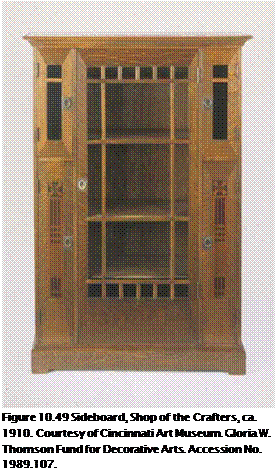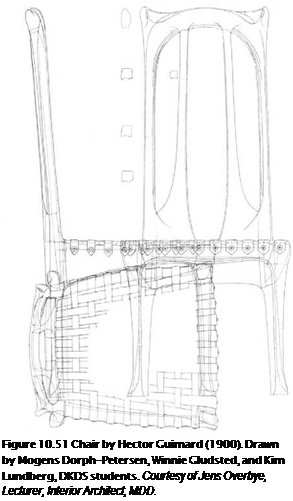The Arts and Crafts movement was inspired by a crisis of conscience. Its motivations were social and moral, and its aesthetic values derived from the conviction that society produces the art and architecture it deserves.9
The American segment of the Arts and Crafts period (1895-1915) was marked by a structural expression of simple form and handmade appearance (Figure 10.49). The primary tenet in design was function. This premise, along with a restrained use of ornamentation and a respect for the nature of the materials used, carried Mission style furniture forward for a quarter of a century.
Gustav Stickley (1858-1942) was influenced by the ideas of John Ruskin and William Morris. Seeking to attain the values of handcrafted work, honesty of materials, beauty, and functional utility, Stickley produced Mission furniture at the turn of the twentieth century in East Aurora, New York. In 1901, Stickley began to publish an influential magazine called The Craftsman, but soon after, Stickley’s ideas about craft began to evolve toward the notion of industrialization, attempting to form a union between skilled
 craftsmen and machine production in furniture that could be marketed to the middle class (Figure 10.50).
craftsmen and machine production in furniture that could be marketed to the middle class (Figure 10.50).
Much has been published regarding aesthetics of Stickley’s furniture produced from 1901 to 1915, but there is relatively little written that describes his philosophical position about design at the turn of the century. In his own words, one can best understand his position about utility, design, and decoration in furniture:
After experimenting with a number of pieces, such as small tables giving in their form a conventionalized suggestion of such plants as the mallow, the sunflower and the pansy.
I abandoned the idea, convinced that such designs failed to satisfy because they were based on a purely decorative form that should never be used for anything whose sole reason for being is in its usefulness. Conventional plant-forms are beautiful and fitting when used solely for decoration, but anyone who starts to make a piece of furniture with a decorative form in mind, stars at the wrong end. The sole consideration at the basis of the design must be the thing itself and not its ornamentation. It must be a chair, a table, bookcase or a bed that fills its mission of usefulness as well as it possibly can; it must be well proportioned and honestly constructed, as beautifully finished as is possible for the wood of which it is made, and as stable, commodious or comfortable as would be required in a perfect thing of its kind. If all these requirements are honestly fulfilled, there is little need of ornament, unless some touch of decoration is suggested by the construction of the piece itself.10
The work of Gustav Stickley and the handcraft community known as the Roycrofters (1895-1938) featured copper fittings and prominent mortise-and-tenon joints, mostly fabricated from ammonia-fumed white oak. Their collective work encouraged handwork, and with it came a revived enthusiasm for craft and the skills necessary to make furniture by hand. Mission furniture was rectilinear, had subtle curved lines, and, when designed by Harvey Ellis (1852-1904), was usually inlaid with stylized floral motifs in colored wood. The Harvey Ellis armchair (1903), made of quarter-sawn white oak with handcrafted inlay, provides support, comfort, and beauty.
Brothers Charles S. and Henry M. Greene (1870-1954) collaborated on many beautifully crafted residences that the two designed and built in Pasadena, California, at the turn of the century. Most
|
Figure 10.50 White oak settee, designed and fabricated by Gustav Stickley, (circa. 1909). Photography by Jim Postell, 2011. |
 renowned was their design for the Gamble House. They crafted wood-joined furnishings for their houses unique to the style of their architecture and sold custom furniture to clients.
renowned was their design for the Gamble House. They crafted wood-joined furnishings for their houses unique to the style of their architecture and sold custom furniture to clients.
Art Nouveau "We are not only at the beginning of a new stylistic phase," wrote the German architect – designer August Endell in 1897, "but at the same time on the threshold of the development of a completely new art."11 From the 1890s until the beginning of World War I, a "New Art" emerged in the major cities throughout the world. Though the style was similar throughout the world, the names for the emerging styles were regional; among them—Art Nouveau, Arte Modernista, Nieuwe Kunst, Sezessionstil, Glasgow Style, Stile Liberty, and Arte Nova.
Art Nouveau (1880-1910) emerged as a style from the opening of Maison Art Nouveau, a furnishing and novelty shop in Paris established by the dealer Siegfried Bing in 1895. The shop displayed furniture and designs for interiors such as glassware by Tiffany and emile Galle and exotic imported goods. The Art Nouveau movement was the first of its kind to occur throughout Europe at the same time. It transcended national boundaries and adopted regional and cultural references.
Hector Guimard (1867-1942) and Henry van de Velde (18631957) of Belgium settled in Paris and fabricated an array of furnishings emphasizing totally harmonious form (Figure 10.51).
Otto Wagner (1841-1918) and members of the Vienna Secession, including Joseph Hoffmann (1870-1956), Koloman Moser (1868-1918), Adolf Loos (1870-1933), and Joseph Maria Olbrich (1867-1908), produced an exceptional body of work that inspired designers throughout the world. Though Hoffmann started his career as a practitioner of Art Nouveau, he soon turned away from its floral abstractions to develop a style that was severe and geometric. The furniture he designed was largely for his own buildings, though it is interesting to note that he did work with Michael Thonet and designed several chairs for him, including the famous cafe chair.
In 1903, Hoffmann and others started a cooperative venture called the Wiener Werkstatte. It lasted until 1932 and was noted for the integration of crafted and machine-produced works. In addition to producing furniture, it periodically exhibited the work of contemporary European designers such as Charles Mackintosh and Henry van de Velde. Until the First World War, the workshops produced furniture, leather goods, metal, glass works, and textiles and had a significant influence on the emerging modern architecture and furniture design.
Henry van de Velde (1863-1957) received his first significant acclaim for the interiors he exhibited at Dresden, Germany, in 1897. He played a leading role in the development of Jugendstil, the German and Austrian equivalent of Art Nouveau that literally means "youth style." His designs for furniture and tableware are
of especially high quality. With ideas derived in part from John Ruskin and William Morris, he taught at his own school, the Weimar School of Arts.
Antoni Gaudi (1862-1926), an engineer, architect, and furniture designer, led the Art Nouveau movement from Barcelona, Spain, and completed a large body of work. Though Gaudi is renowned for his architecture, he designed many beautiful chairs and tables throughout his long career (Figure 10.52).




